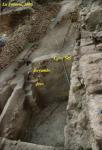Summary (English)
This Phoenician port settlement (8th to 6th c. BC) is located at the mouth of Segura River. Its urbanised surface could have reached 8 ha, thus being one the most important urban hubs of the Western Mediterranean; to this can be added the quality of the archaeological register preserved by sand coverage and the significant remains of metallurgic activities.
Cleaning operations and preliminary definition of the zone to be explored were carried out in June 2000). Drilling was performed in the northern third of Section 54, which permitted verification of how archaeological works carried out in 1996 did not completely take out all the rocks that had fallen from the La Fonteta IV wall when it collapsed. The drilling confirmed expectations, giving rise to the opening of two planned sections: an extensive sedimentological sondage of an archaic phase in the Phoenician site.
After removing the dune sand, up to1m thick, a solid bed with heavy stones was revealed, corresponding to the collapsed wall that initiated the recent stage of the Phoenician settlement. Cleaning of this stone bed led to the discovery of several baetyl stelae, similar to the ones recovered in 1996 in the internal and external collapses of the wall. These findings confirm the reuse of religious elements from the La Fonteta archaic phase.
This stratigraphy showed the existence of a moat or embankment located just a short distance from the wall and an adobe parapet on a heavy stone plinth; the latter runs parallel to the external facing wall, so that a complementary functionality can be concluded with respect to the wall).
The archaeological material recovered from these archaic deposits comprises one of the most complete Phoenician pottery groups of the 8th c.; this ensemble completes the existing information for similar Andalusian deposits (Huelva, Castillo de Doña Blanca, Málaga, Morro de Mezquitilla, Chorreras and Toscanos). Also recovered were many iron and copper ingots and slags, sandstone moulds, crucibles, nozzles and mineral silver residues. We can highlight the findings of tools (bronze hooks) and ornaments (a scarab piece with hieroglyphics engravings, ivory objects, faience, carnelian and quartz beads, rings and pierced plaques recovered in industrial activity levels, not in habitat levels. Also important is the amount of ostrich egg vessels, many decorated with geometric and flowered motifs. Three weights, one bronze and the rest lead, characteristic of the weight system used in Phoenician Mediterranean settlements, are highly significant culturally.
Proto-Corinthian pottery and Attic amphorae of the SOS type found in La Fonteta II dumps have helped to date this deposit to the end of the 8th c. BC.
Summarizing, the most important contributions of this campaign were of an archaeological and palaeo-ecological nature. On the one hand, an exterior parapet system was identified that precedes the eastern face of La Fonteta IV wall, perhaps to contain the advance of the dunes. On the other, for the archaic phase of the site, La Fonteta II metallurgical remains show a wide range of its material and technological culture. To this we can add the discovery of the old beach and coastline used as a dump for metallurgic activities of Phoenician craftsmen in the 8th c. century BC.
- Alfredo González Prats
Director
- Alfredo González Prats
Team
- Museo Arqueológico, Etnológico y Paleontológico Municipal
Research Body
- Diputación Provincial de Alicante






![Download [PDF]](/excavation/skins/fasti/images/results/download_sml.png)
